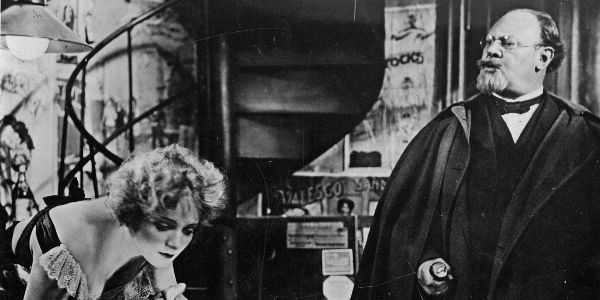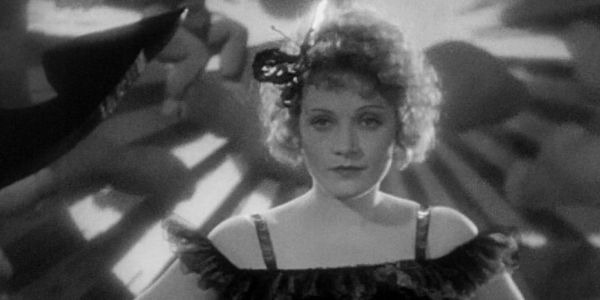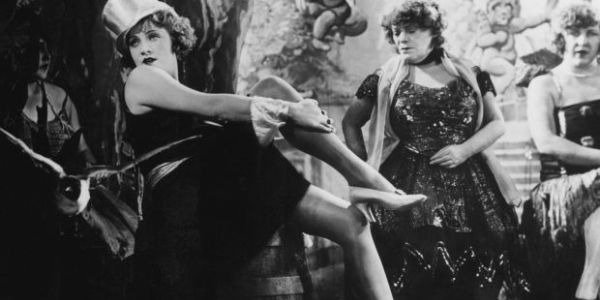THE BLUE ANGEL at 90 and the Iconography of Marlene Dietrich

Film and television writer published at Bright Wall/Dark Room, The…
The start of the 2020s is the ideal opportunity to revisit the iconic cinema of Weimar Germany. These inter-war pieces tended to capture the devastation and despair lying just under the surface of a brave new world. Decadence heralded the end of former sexual mores, and yet this freedom and eroticism often enhanced the feeling that the world was crumbling around every carefree participant. It is an atmosphere that remains evocative and familiar today.
A key voice in Weimar cinema
Josef von Sternberg was a key voice in Weimar cinema, beginning his career at Babelsberg and then bringing his signature chiaroscuro compositions and fascination with obsessive characters to Hollywood. The film that catapulted him and his star Marlene Dietrich to international fame and facilitated this transatlantic shift was The Blue Angel (1930), currently playing on MUBI USA as part of their Weimar Berlin series. Ninety years after the film’s premiere, the story of a schoolteacher’s ruin at the hands of a showgirl comes across as old fashioned on paper. That said, it plays into archetypes familiar throughout Western art: the breakdown of traditional morality, infatuations leading to ruin, and the femme fatale who remains strangely blameless for the destruction she wreaks.

Sternberg’s tale retains its freshness and power despite the tropes at play through an intense focus on the personal. The film follows Professor Rath (Emil Jennings) as he goes to The Blue Angel, the local cabaret, with the initial goal of reprimanding cabaret star Lola Lola for distracting his students. However, he soon falls under her spell, giving up profession and security to marry her – and then discovering that their lives were entirely incompatible. To Professor Rath, Lola is a “shared woman” – and his world is rapidly disappearing. Sternberg’s vision of a sexually liberated society, however, is far from fire and brimstone; in his pre-Hays days, he could explore the equalities and moral neutrality, almost inoffensiveness, of this unorthodox arrangement. The anxieties reflected in the film seem to belong more to Rath than to the story as a whole – and Rath pays for this perceived degradation with his life.
Marlene Dietrich
Rath’s story may provide dramatic impetus, but Lola provides the magnetism. Dietrich’s screen debut could not have been more auspicious. The German Hollywood star found international fame in The Blue Angel, and her incandescent, effortlessly seductive Lola lives life by the rules she writes. It would be unfair to Lola and Dietrich’s portrayal to say Lola is amoral – she clearly has a code, but one that disregards any previously written moralities.
It is hard to think of a performer who has more wholly embodied the idea of an icon. Before I had ever seen one of Dietrich’s films, I had her image burned into my mind: the impeccably tailored suits, the high arched eyebrows, and the androgynous liberty. Even when I was twenty, walking alone through the Berlin Filmmuseum and a newcomer to the world of Weimar cinema, her image was instantly recognisable, remarkably individual, and evoked a certain déjà vu even though I was certain this was my first knowing encounter with her image. “An enigmatic glimmer, a je-ne-said-pas-quoi, flashes in the eyes of a beautiful woman,” sings Lola Lola; the statement could just as easily be applied to Dietrich’s entire Hollywood history as it does one lone cabaret singer.

Dietrich may be of the most recognisable figures of Hollywood’s Golden Age, but she is still shrouded in a mythos that adds to her legend. She was openly bisexual and claimed hosts of confirmed and unconfirmed lovers; for instance, Kenneth Anger claimed in his quasi-memoir Hollywood Babylon that Dietrich and Claudette Colbert had been lovers – it is not improbable, based on what we know of the star actresses, but it is also entirely unsubstantiated. Affairs with James Stewart, Yul Brynner, Gary Cooper, and Mercedes de Acosta are supported by more established historical documentation.
No small part shaped by men
Like many leading ladies in early Hollywood, Dietrich’s image was in no small part shaped by the men around her – Sternberg included. Following the success of The Blue Angel that took the pair of them to Hollywood, the director continued as Dietrich’s personal and professional coach. He ordered her to lose weight to fit the American mold and maintained an imperious directorial relationship that scared off many collaborators – but not Dietrich. The result was a further six films that cemented both artists’ legacies and paved the way for Dietrich’s future Hollywood success. Film historian John Baxter cites production assistant John Kahan as saying that Dietrich was a “second rate actress” with an ungainly, charmless stage presence until Sternberg’s tutelage.

This assessment, however, feels ungenerous, considering Kahan also remembered Sternberg’s immediate insistence, prior to Dietrich’s first audition, that this would be his Lola. Dietrich’s own voice and magnetism in the roles and films she left her mark on cannot be denied or discounted. When watching her performances, what comes through is an acute awareness of the camera’s lens and the audience’s eye. Here, there is confidence that no director could have faked. Dietrich could not have known her own legacy, but watching her perform ninety years after the fact leaves the impression that she was not just performing for her own time.
Conclusion
This natural assuredness and sex appeal is never more evident than it is in “Falling In Love Again”, her signature song that first appeared in The Blue Angel. The staging is not accompanied by any cinematographic tricks and advanced choreography; instead, Dietrich sits askance on a chair, one leg held halfway in the air. She occasionally moves her limbs but never leaves the chair – the audience is already captivated, and there is no need for her to do more. She maintains a similar seated position in the finale reprise, this time straddling the chair at a diagonal to the audience, looking almost straight down the camera. And for those familiar with the English lyrics she later recorded, the original German is far more suggestive: “Ich bin von Kopf bis Fuss / aus Liebe eingestellt” – “I am from top to toe, ready for love.” With just her voice and her eyes, Dietrich lays bare Lola’s body and heart – and we, like Rath, fall under her spell.
What is your favorite Marlene Dietrich film? Let us know in the comments below!
Does content like this matter to you?
Become a Member and support film journalism. Unlock access to all of Film Inquiry`s great articles. Join a community of like-minded readers who are passionate about cinema - get access to our private members Network, give back to independent filmmakers, and more.
Film and television writer published at Bright Wall/Dark Room, The Skinny, Screen Queens, One Room With a View, and FlipScreened. Mamma Mia: Here We Go Again is a cinematic masterpiece.













